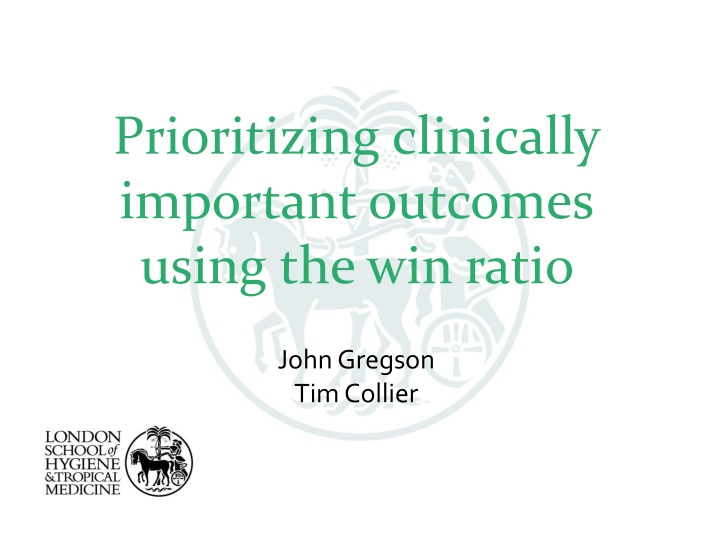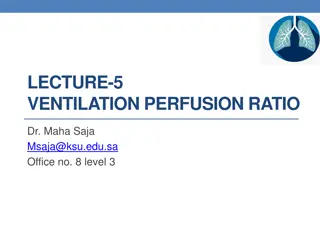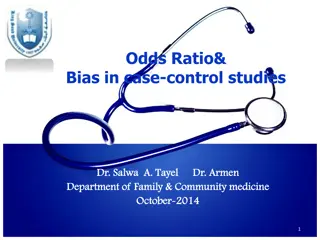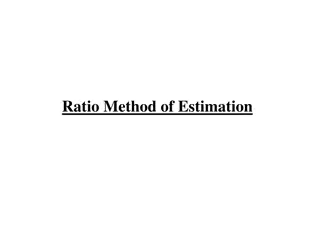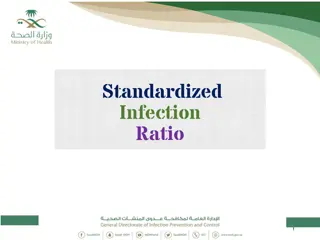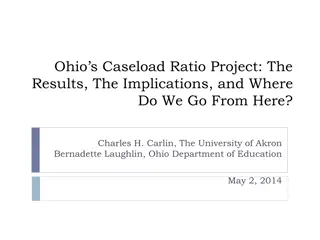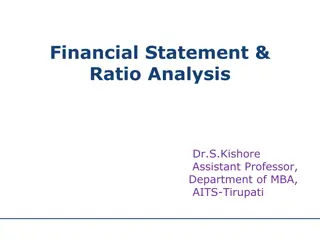Prioritizing Clinically Important Outcomes Using Hierarchical Win Ratio
Clinical trials often use composite outcomes, but conventional analysis methods have limitations in accurately reflecting clinical reality. Hierarchical outcomes offer flexibility by defining a hierarchy of events based on importance. Analyzing trials using hierarchical outcomes involves comparing pairs of treated and control patients to determine the win ratio, which indicates benefit or harm. Strength of evidence is evaluated using the win ratio and statistical tests like the Finkelstein-Schoenfeld test.
Download Presentation

Please find below an Image/Link to download the presentation.
The content on the website is provided AS IS for your information and personal use only. It may not be sold, licensed, or shared on other websites without obtaining consent from the author.If you encounter any issues during the download, it is possible that the publisher has removed the file from their server.
You are allowed to download the files provided on this website for personal or commercial use, subject to the condition that they are used lawfully. All files are the property of their respective owners.
The content on the website is provided AS IS for your information and personal use only. It may not be sold, licensed, or shared on other websites without obtaining consent from the author.
E N D
Presentation Transcript
Prioritizing clinically important outcomes using the win ratio John Gregson Tim Collier
Contents Introduction to hierarchical outcomes and the win ratio An example analysis using the win ratio winratiotest: our Stata package for analysis using the win ratio
Conventional composite outcomes Clinical trials regularly use composite outcomes 2 or more distinct component events (e.g. death and heart failure hospitalization [HFH]) Often analysis uses time-to-first event Cox proportional hazards models Hazard ratio, 95% CI, p-value Limitations: Components count equally (e.g. HFH counts same as death) Only first event counted HFH followed by death death ignored
Limitation of conventional composite outcomes Death A HFH B Censored Conventional analysis: patient A s experience is worse But does not reflect clinical reality Hierarchical outcomes can help
Hierarchical outcomes Provide flexibility by defining a hierarchy of events Death most important HFH next most important Evaluate outcomes in order. Stop once patients are untied A B Patient B died first, therefore Patient A is the winner Neither patient dies - go to next outcome (HFH) Patient B is the first to have a HFH. Patient A is the winner A B Death HFH Censored
Analyzing trials using hierarchical outcomes Involves comparing pairs of treated and control patients Compare pairs of patients Treated patient has better outcome = win Control patient has better outcome = loss The same outcomes (e.g. no death or HFH) = tie Do this for all possible pairs of patients (unmatched win ratio) Compare all Nttreated patients to all Nccontrol patients (i.e. NtNc comparisons)
Analyzing trials using hierarchical outcomes Need measure of benefit: win ratio (Eur Heart J. 2012:33(2):176-82) # wins / # losses Win ratio > 1 means benefit, Win ratio < 1 means harm Need a way to evaluate strength of evidence: Does treated patient win (significantly) more often than they lose P-value Finkelstein-Schoenfeld test (Statist. Med. 1999: 18, 1341 1354)
Example 1: COAPT Heart failure patients Mitraclipdevice arm (n=302) Control (n=312) Followed up for 12-24 months Outcome for win ratio analysis: Death or HFH Unmatched win ratio Compare all Nttreated patients to all Nccontrol patients (i.e. NtNccomparisons)
Example win ratio analysis in COAPT For a random pair of patient, the odds that the better outcome occurs in the treated patient=1.61 66.4% of decisions 33.6% of decisions
winratiotest syntax tells winratiotest which variables form part of the outcome, and how to analyse them winratiotest idvar trtvar, outcomes(list) List consists of 3 parts: 1) the (main) variable name for this outcome 2) the type of outcome, options are c for continuous, ordinal or binary tf for time-to-failure, ts for time-to-success r for repeat events 3) Depends on the type of the outcome. For continuous, ordinal or binary it is the direction (< for lower is better, > for higher is better) For other outcomes it gives the event (or censoring time) Unique subject identifier Randomised treatment [0=control, 1=active]
winratiotest optional syntax winratiotest idvar trtvar, outcomes(list) [outcomes(list) outcomes is a repeated option each instance represents an outcome in the hierarchy strata(varname) stweight(method) The order they are specified is their priority in the hierarchy pformat(%fmt) wrformat(%fmt) saving(filename, replace)]
Example: Death and quality of life Trial of new medication Outcome is a hierarchical outcome -Time to death as most important -Quality of life amongst those who survive (higher is better)
Example: Death and quality of life winratiotest idvar trtvar, outcomes(list) outcomes(list) winratiotest patid trt, outcomes(dth tf fudth) outcomes(qol c >)
winratiotest output winratiotest patidtrt, outcomes(dth tf fudth) outcomes(qolc >) Total number of patients: 800 Number in control group: 400 Number in active group: 400 Number of comparisons: 160000 Wins Losses Ties Outcome 1 23182 19870 Outcome 2 76572 40369 Total 99754 60246 0 Win Ratio: 1.66, 95% CI(1.41, 1.95) P<0.0001 Statistics available using return list . Or using the option [saving()]
Comparison to other software Software Outcome types Strata? Margins? Other win statistics Speed Winratiotest Binary, ordinal continuous, time-to- event, repeat events Yes Yes No SLOW R: WinRatio Binary, ordinal continuous, time-to- event, repeat events No No No FAST R: WINS Binary, ordinal, continuous, time-to- event Yes Yes Yes FAST R: wwr Two time-to-failure outcomes No No No FAST SAS No (general) publicly available software
Sample size calculations Software available for analysis But power calculations needed to design studies using win ratio Sample size calculations complex conventionally done by simulation EMPULSE (trial in heart failure): Powers for superiority were estimated by simulation using a shared frailty approach. Initially a frailty value was simulated for each patient using a gamma distribution. Deaths were assumed to have constant hazard for any given patient dependent upon the frailty term, leading to a marginal Lomax distribution. HFEs were assumed to have a Poisson distribution within patients, again depending on the frailty parameter, leading to a marginal negative binomial distribution. The number of HFEs per patient was nominally capped at 7 per patient over the 90-day period. For KCCQ-TSS, the frailty terms were directly transformed into a capped normal distribution (values below 0 or above 100 set to 0 and 100 respectively). High frailties corresponded to low KCCQ-TSS scores and vice versa. The use of a shared frailty parameter ensures correlation between components of the primary endpoint so that patients with poor outcomes in one component are also more likely to have a poor outcome in the others. Ten thousand simulations were used for each scenario.
Sample size calculations Formulae developed (Stat Med 2022; 41: 950). but required inputs abstract the proportion of ties the effect size (win ratio) quite abstract clinicians / trialists do not think in these We developed software to translate from conventional inputs (rates , proportions, mean differences) and calculate sample size
winratiopower for sample size calculations winratiopower , [ power(number) alpha(number) nratio(number) outcome(outcome_type outcome_options) ] Example: 80% power, 5% significance level Hierarchy: (1) Time-to-failure event outcome. -15% frequency in control group -Hazard ratio associated with intervention 0.7 (2) Continuous (assumed to be normally distributed) outcome -A higher value is better -Mean values 6 and 0, SD=20 in both arms winratiopower , power(0.80) alpha(0.05) outcome(tf eventprob(0.15) hr(0.7)) outcome(c win(higher) mean(6 0) sd(20 20))
winratiopower for sample size calculations Study parameters: alpha = 0.0500 power = 0.8000 Estimated percentage of wins, losses and ties: Level Wins Ties Losses Level 1 0.14 0.76 0.10 Level 2 0.44 0.00 0.32 Overall 0.59 0.00 0.41 Estimated sample size: N = 354.9 N per group = 177.5
Conclusions and future work winratiotestallows flexible analysis of hierarchical outcomes Functionality comparable with equivalent packages in R Flexible sample size calculations unique to Stata Future work Improve speed Other measures of treatment benefit for hierarchical outcomes (e.g. win benefit)
